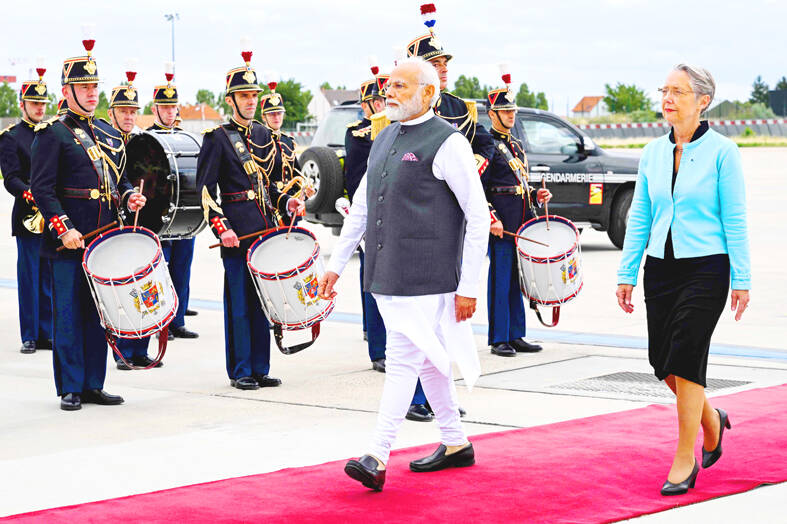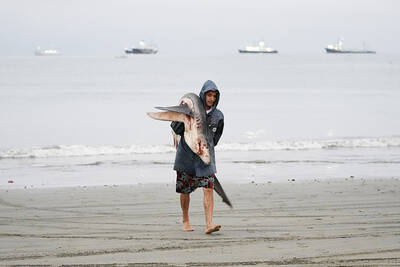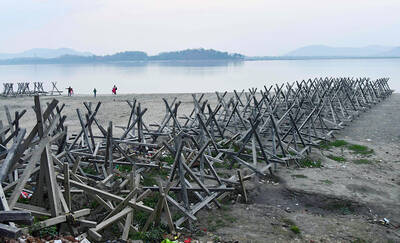France and India are closing in on a deal to build three conventional diesel-electric submarines as the South Asian country diversifies purchases of military hardware beyond Russia and positions itself as a bulwark against China.
Negotiations on the submarines from France are nearly complete, said senior Indian officials aware of the details who asked not to be named because the discussions were private.
An announcement could come during Indian Prime Minister Narendra Modi’s two-day visit to France that began yesterday and includes talks with French President Emmanuel Macron.

Photo: AFP
India’s Defense Acquisition Council is expected to formally approve the project later in the day, the officials said.
The agreement to build submarines with France is the latest defense deal that Modi’s government is pushing through, as Moscow and Beijing have deepened ties in the aftermath of Russia’s war in Ukraine. India is presenting itself as a key partner in Asia for Washington and its allies, as China asserts itself over Taiwan. To draw New Delhi closer they are offering sophisticated weapons platforms and investments.
The two countries are already building Scorpene submarines and the last of six boats being manufactured by India’s Mazagon Dock Shipbuilders Ltd would be ready early next year. The latest agreement with Paris would follow soon after India’s recent pact with Germany’s Thyssenkrupp AG’s marine arm to manufacture diesel submarines at an estimated cost of US$5.2 billion.
India’s ministries of external affairs and defense did not comment.
A spokesperson for France’s Naval Group SA, which manufactures the submarines, and Macron’s office declined to comment.
Modi’s visit to France “would be both rich in substance and also in form,” Indian Foreign Secretary Vinay Kwatra told reporters on Wednesday. “We believe that it would set new benchmarks for our strategic partnership in years ahead.”
The French submarines would be built in Mumbai, adding heft to the underwater capabilities of the Indian Navy whose fleet of German and Russian vessels is aging.

WAKE-UP CALL: Firms in the private sector were not taking basic precautions, despite the cyberthreats from China and Russia, a US cybersecurity official said A ninth US telecom firm has been confirmed to have been hacked as part of a sprawling Chinese espionage campaign that gave officials in Beijing access to private texts and telephone conversations of an unknown number of Americans, a top White House official said on Friday. Officials from the administration of US President Joe Biden this month said that at least eight telecommunications companies, as well as dozens of nations, had been affected by the Chinese hacking blitz known as Salt Typhoon. US Deputy National Security Adviser for Cyber and Emerging Technologies Anne Neuberger on Friday told reporters that a ninth victim

Russia and Ukraine have exchanged prisoners of war in the latest such swap that saw the release of hundreds of captives and was brokered with the help of the United Arab Emirates (UAE), officials said on Monday. Ukrainian President Volodymyr Zelenskiy said that 189 Ukrainian prisoners, including military personnel, border guards and national guards — along with two civilians — were freed. He thanked the UAE for helping negotiate the exchange. The Russian Ministry of Defense said that 150 Russian troops were freed from captivity as part of the exchange in which each side released 150 people. The reason for the discrepancy in numbers

A shark attack off Egypt’s Red Sea coast killed a tourist and injured another, authorities said on Sunday, with an Italian Ministry of Foreign Affairs source identifying both as Italian nationals. “Two foreigners were attacked by a shark in the northern Marsa Alam area, which led to the injury of one and the death of the other,” the Egyptian Ministry of Environment said in a statement. A source at the Italian foreign ministry said that the man killed was a 48-year-old resident of Rome. The injured man was 69 years old. They were both taken to hospital in Port Ghalib, about 50km north

POWER PLAY: The dam is planned to more than triple the 88.2 billion kilowatt-hours designed capacity of the Three Gorges Dam, which is currently the world’s largest China has approved the construction of what would be the world’s largest hydropower dam, launching an ambitious project on the eastern rim of the Tibetan plateau that could affect millions downstream in India and Bangladesh. The dam, which would be in the lower reaches of the Yarlung Zangbo River, could produce 300 billion kilowatt-hours of electricity annually, according to an estimate provided by Power Construction Corp of China in 2020. That would more than triple the 88.2 billion kilowatt-hours designed capacity of the Three Gorges Dam, currently the world’s largest, in central China. The project would play a major role in meeting China’s